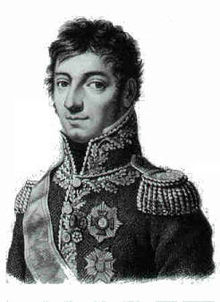- Charles Lefebvre-Desnouettes
-
Charles, comte Lefebvre-Desnouettes or Lefèbvre-Desnoëttes (1773 – 22 May 1822) became a French officer during the French Revolutionary Wars and a general during the Napoleonic Wars. He later emigrated to the United States.[1]
Contents
French Revolutionary Wars
He joined the army in 1792, and served with the armies of the North, of the Sambre et Meuse and Rhine et Moselle in the various campaigns of the French Revolution. Six years later he had become captain and aide-de-camp to General Napoleon Bonaparte. At the Battle of Marengo in June 1800 he won further promotion.
Empire
Under the Empire, Lefebvre-Desnouettes fought with distinction at the Battle of Elchingen in 1805. Later that year, he became colonel after the Battle of Austerlitz. He served also in the Prussian campaigns of 1806-1807. He was promoted to general of brigade in September 1806 and general of division in November 1807. He was created a count of the Empire in March 1808.
Sent with the army into Spain, he conducted the first and unsuccessful Siege of Saragossa. Later he commanded the IV Corps in several actions in Spain. On 29 December 1808, he was taken prisoner in the action of Benavente by the British cavalry under Henry Paget (later Lord Uxbridge, and subsequently Marquis of Anglesey).
For over two years Lefebvre-Desnouettes remained a prisoner in England, living on parole at Cheltenham. In 1811 he broke his parole, an act which greatly offended British public opinion, and escaped; in the invasion of Russia in 1812, he led the Guard Chasseurs à Cheval cavalry. In 1813 and 1814, he and his men distinguished themselves in most of the great battles, especially Brienne (where he was wounded), La Rothière, Montmirail, Vauchamps and Arcis-sur-Aube. He joined Napoleon in the Hundred Days and was appointed commander of the Guard Light Cavalry Division, which he commanded at the Battle of Quatre Bras. At the Battle of Waterloo he was wounded.[2]
Later career
For his part in the Hundred Days he was condemned to death by the royalists, but he escaped to the United States and spent the next few years farming in the ill-fated Vine and Olive Colony, beginning in 1817.[3] His frequent appeals to Louis XVIII eventually obtained his permission to return, but the Albion, the vessel on which he was returning to France, went down off the coast of Ireland with all on board on 22 May 1822. He is recognized as LEFÈBVRE-DESNte on the 31st column of the Arc de Triomphe in Paris.[4]
His widow had an obelisk, known as the 'Pain de Sucre' due to its shape and frequent re-painting in white, erected to his memory and that of the sailors who perished with him. It stands above the sea on the crest of a low hill in Sainte-Adresse, now a suburb of Le Havre, and doubled as a navigation mark helping other sailors avoid the hazards in the approach to the port.
References
- ^ "Charles Lefebvre-Desnouettes, 1755-1820". Historyofwar.org. http://www.historyofwar.org/articles/people_lefebvre_desnouettes.html. Retrieved 2010-08-16.
- ^ "The Top Twenty French Cavalry Commanders: General Charles Lefebvre-Desnouettes". Napoleon-series.org. http://www.napoleon-series.org/research/commanders/c_desnouettes.html. Retrieved 2010-08-16.
- ^ "Vine and Olive Colony". Encyclopedia of Alabama. 2010-01-21. http://encyclopediaofalabama.org/face/Article.jsp?id=h-1539. Retrieved 2010-08-16.
- ^ Information on the 'Pain de Sucre' from visit and inscription on monument.
External links
- Smith, Digby. The Napoleonic Wars Data Book. London: Greenhill, 1998. ISBN 1-85367-276-9
- Charles Lefebvre Desnouettes Letters, 1818-1819., Wilson Library at the University of North Carolina
- Philip J. Haythornthwaite (2001). Napoleon's Commanders (1) C1792-1809. Illustrator Patrice Courcelle. Osprey Publishing. ISBN 9781841760551. http://books.google.com/books?id=ZLcrl3XOoHAC&pg=PA42&lpg=PA42&dq=Charles+Lefebvre-Desnou%C3%ABtte&source=bl&ots=2OqmgF9MTL&sig=CtMqxuldcOdAxBzUKe0svJ6tNGw&hl=en&ei=0CJoTNaCD4L6lwfP1_GeBQ&sa=X&oi=book_result&ct=result&resnum=3&ved=0CBcQ6AEwAjgK#v=onepage&q&f=false.
 This article incorporates text from a publication now in the public domain: Chisholm, Hugh, ed (1911). Encyclopædia Britannica (11th ed.). Cambridge University Press.
This article incorporates text from a publication now in the public domain: Chisholm, Hugh, ed (1911). Encyclopædia Britannica (11th ed.). Cambridge University Press.
Categories:- French commanders of the Napoleonic Wars
- Commanders in the French Imperial Guard
- French generals
- 1773 births
- 1822 deaths
Wikimedia Foundation. 2010.

